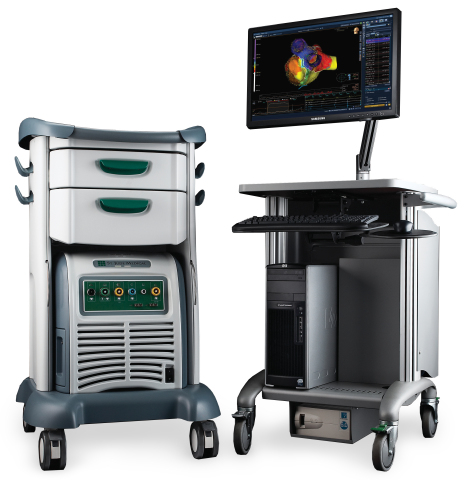St. Jude Medical announced a full market release of its EnSite Precision™ cardiac mapping system
OREANDA-NEWS. St. Jude Medical, Inc. (NYSE:STJ), a global medical device company, today announced a full market release of its EnSite Precision™ cardiac mapping system and new Sensor Enabled™ tools in Europe. The new platform is now installed and active in more than 100 sites across Europe and has been used to support more than 5,000 ablation cases since the system’s CE Mark approval in January 2016.
This Smart News Release features multimedia. View the full release here: http://www.businesswire.com/news/home/20161005005169/en/

The St. Jude Medical™ EnSite Precision™ cardiac mapping system transforms procedures for patients with cardiac arrhythmias with intuitive automation, flexibility and accuracy. (Photo: St. Jude Medical, Inc.)
Used in ablation procedures to visualize and navigate catheters in the heart, the EnSite Precision cardiac mapping system provides highly detailed anatomical models and maps to effectively enable diagnosis of a wide range of arrhythmias (abnormal heart rhythms) — including complex cases of atrial fibrillation and ventricular tachycardia — and guide therapy. The system combines magnetic and impedance technologies to transform procedures with intuitive automation, expanded procedural options and tailored care using superior flexibility and it allows effective management of patients through greater accuracy.
“I see the most significant impact of this technological platform in supporting ablation cases in patients with complex and advanced cardiac arrhythmias,” said Prof. Gerhard Hindricks, director of the Department of Electrophysiology at University of Leipzig Heart Center in Germany. “Today, we are seeing more and more patients with complex and demanding cardiac arrhythmias, which require a very, very precise and fast analysis and ablation strategy. The EnSite Precision platform supports it all, from fast access to target sites, fast and precise mapping data generation to automatic data analysis.”
The EnSite Precision cardiac mapping system is flexible and enhances workflow efficiency by allowing physicians to optimize mapping of the heart chambers using the new St. Jude Medical™ Sensor Enabled toolset and customize procedures to address the circumstances of each case. The FlexAbility™ Ablation Catheter, Sensor Enabled™ can enhance procedural versatility and precision; it combines an advanced handle with a bendable irrigated catheter tip to conform to the cardiac anatomy allowing for effective lesion formation. Designed for advanced handling and maneuverability, the Advisor™ FL Circular Mapping Catheter, Sensor Enabled™ allows for precise navigation and model creation with impedance-field flexibility and magnetic-field stability.
The EnSite Precision cardiac mapping system also allows real-time catheter navigation to occur using minimal fluoroscopy, thus reducing potential for risks associated with excessive radiation exposure for patients and clinicians.
“We collaborated with leading electrophysiologists to develop a cardiac mapping system that provides the automation, flexibility and precision needed during today’s ablation procedures,” said Dr. Mark Carlson, chief medical officer and vice president of medical affairs at St. Jude Medical. “We are extremely pleased with how the physicians from these European sites have embraced the system and are excited to expand its availability as we seek more approvals.”
In addition to Europe, the EnSite Precision cardiac mapping system is available in other markets, including Hong Kong and Singapore. St. Jude Medical is pursuing Food and Drug Administration clearance to make the system available in the United States.
About Cardiac Ablation
When physicians use catheter ablation to treat abnormal heart rhythms (arrhythmias), several long, flexible tubes with wires — called catheters — are inserted into the heart. Diagnostic catheters record electrical information from the heart and display it in a three-dimensional anatomical model, which is used to study the abnormal rhythm.
Another catheter is used for the actual ablation. The doctor positions the ablation catheter so it lies on or very close to the targeted tissue. The small area of heart tissue under the tip of the ablation catheter is heated by high-frequency energy, creating a lesion or tiny scar. As a result, this tissue is no longer capable of conducting or sustaining the arrhythmia.
About St. Jude Medical’s Electrophysiology (EP) Business:
St. Jude Medical’s electrophysiology (EP) business is one of the fastest growing segments within St. Jude Medical’s portfolio. The company’s EP product portfolio gives physicians the diagnostic, access, mapping and therapy solutions they need with designed integration for enhanced diagnosis and treatment of heart arrhythmias. A leader in collaborating with world-renowned electrophysiologists, clinicians and hospital administrators, St. Jude Medical develops safe and cost-effective treatment solutions for patients in need of advanced ablation therapies. The EnSite Precision cardiac mapping system was developed to be used seamlessly with the existing portfolio of St. Jude Medical™ EP products, including the TactiCath™ Quartz Ablation Catheter System, the FlexAbility™ Ablation Catheter, the Ampere™ RF Generator and the Agilis™ NxT Steerable Introducer.




Комментарии